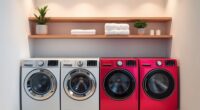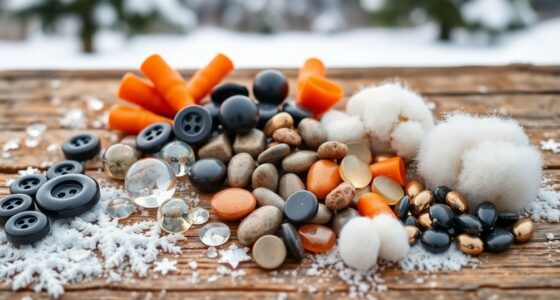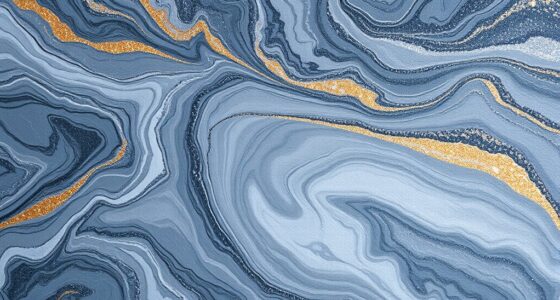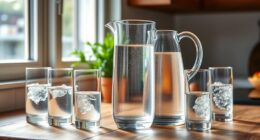When choosing between airless and HVLP paint sprayers, consider your project size and surface type. Airless sprayers work best for large jobs and thicker materials, delivering quick coverage. In contrast, HVLP sprayers offer finer finishes, making them ideal for smaller, detailed tasks. If you’re a beginner, HVLP is easier to handle. By understanding these differences, you can pick the right sprayer for your needs and achieve great results. There’s more to explore about each type!
Key Takeaways
- Airless sprayers are ideal for large projects, offering quick coverage and handling thicker paints effectively.
- HVLP sprayers excel in detailed work on smaller tasks, providing smoother finishes with minimal overspray.
- Choose airless sprayers for exterior surfaces and rough textures, while HVLP sprayers suit intricate projects and smooth surfaces.
- Airless sprayers operate at high pressure, resulting in more paint waste compared to the higher transfer efficiency of HVLP sprayers.
- Beginners may find HVLP sprayers easier to use for medium-sized projects, thanks to their simpler setup and controlled application.
Overview of Paint Sprayers
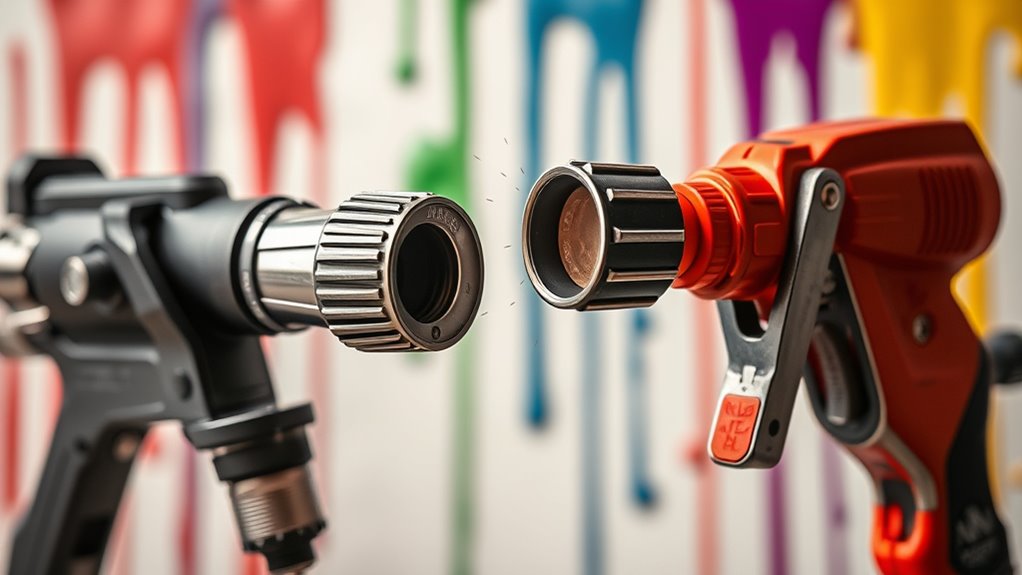
When you need to tackle a painting project, understanding the different types of paint sprayers can make a significant difference in your results.
Paint sprayers are versatile tools that deliver even coats quickly, making them perfect for both large and detailed jobs. You’ll find two primary types: airless paint sprayers and HVLP (High-Volume, Low-Pressure) sprayers. Airless sprayers work well for larger projects and thicker paints, providing a robust spray pattern across large surface areas. On the other hand, HVLP sprayers excel in offering a fine finish for smaller tasks, minimizing overspray. Additionally, many professional painters prefer using advanced filtration systems to ensure clean air while working on projects. Airless technology allows for efficient coverage and is particularly effective with thicker coatings, enhancing your painting experience. Regular maintenance of your spray equipment, such as monitoring air quality indicators, can also optimize performance. It’s important to note that cleaning the sprayer after use is essential to prevent clogs and ensure longevity.
By knowing the strengths of each type, you can achieve a uniform finish tailored to your specific project requirements and materials. Additionally, understanding color accuracy in your painting can enhance the overall appearance of your work.
Choose wisely for the best results!
Airless Paint Sprayers
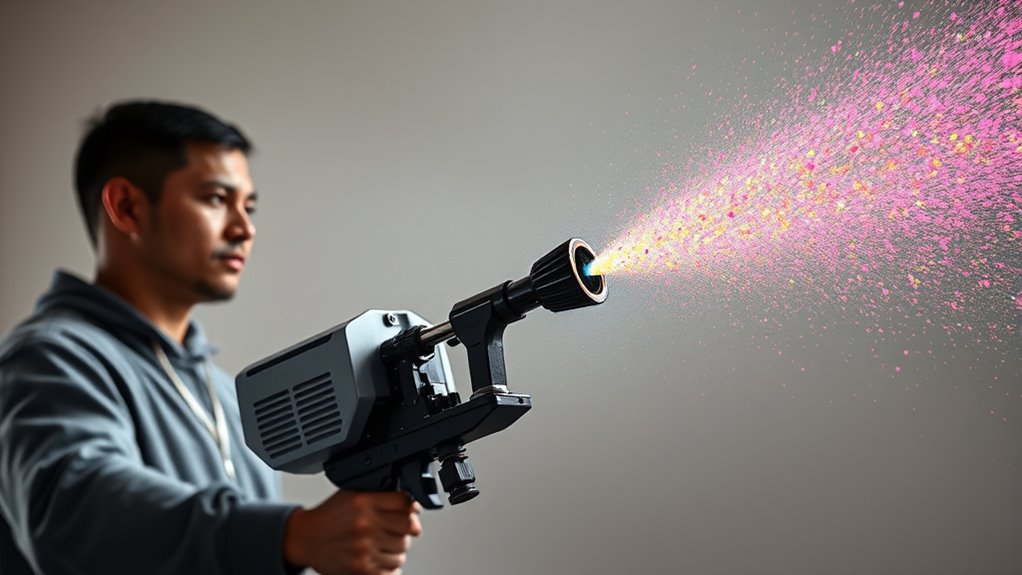
Airless paint sprayers are powerful tools that revolutionize the way you tackle painting projects. Operating at high pressure, these sprayers apply thick paints and coatings quickly, making them perfect for large projects, both indoors and outdoors.
With an airless sprayer, you can effortlessly pump paint directly from a container to the spray gun, eliminating the need for compressed air. This means you get professional-quality results with less setup and cleanup time. Additionally, their time-efficient application significantly reduces project duration, making them a preferred choice for many DIY enthusiasts. These sprayers are also known for their ability to provide a smooth finish that rivals traditional painting methods. Furthermore, airless sprayers are designed to reduce pollutants in your workspace, contributing to a healthier environment. The versatility of these sprayers allows them to handle a variety of thick paints effectively, ensuring you can tackle different types of projects with ease.
Plus, the high-speed application greatly boosts your productivity, allowing you to cover vast surfaces in a fraction of the time compared to traditional methods. Just keep in mind that the high pressure can lead to overspray, so controlling the spray pattern is essential for achieving the best finish. Proper paint flow ensures smooth application and prevents clogging during use.
HVLP Sprayers
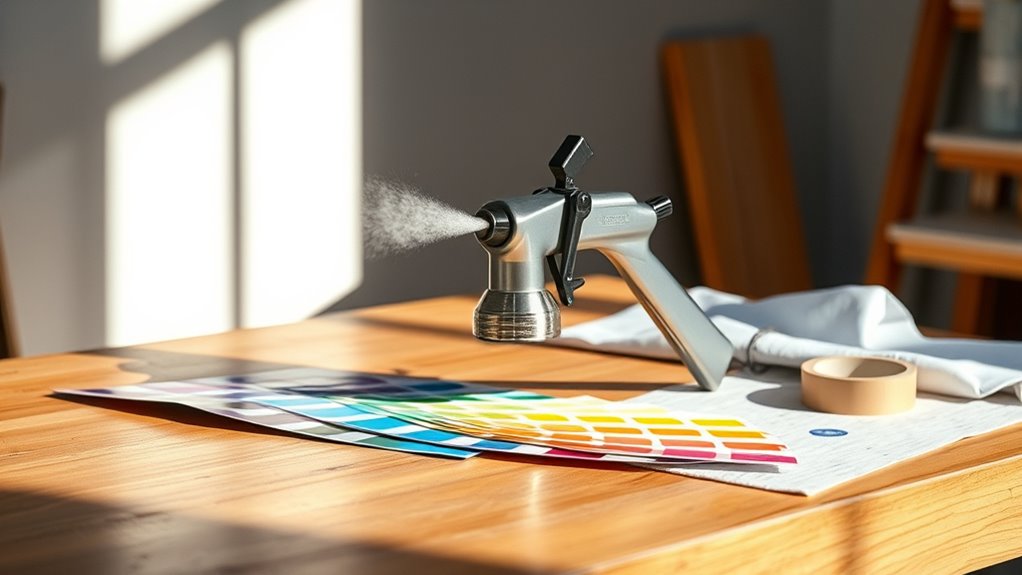
HVLP sprayers excel at providing better surface finishes on smooth surfaces, thanks to their controlled spray cone. Plus, they’re typically more budget-friendly than airless sprayers, with a simpler setup involving just a spray gun and air compressor. Additionally, using an air purifier while painting can help reduce the concentration of harmful VOCs in the air, creating a healthier working environment. Regular maintenance of the equipment can also enhance performance and longevity, ensuring a consistent cleaning efficiency for your projects. While they may not be suited for larger quantities of paint due to a slower application process, their precision is hard to beat for detailed work. Additionally, they are particularly effective for achieving smooth finishes on furniture and cabinetry, enhancing the overall aesthetic of your projects.
Key Differences Between Airless and HVLP
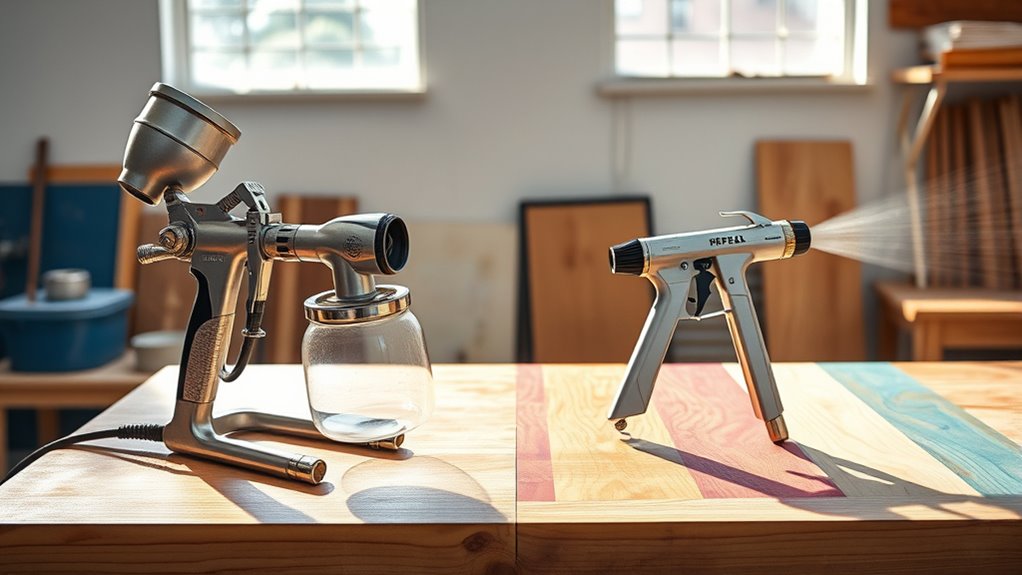
When choosing between airless and HVLP sprayers, you’ll notice key differences in pressure and efficiency that can impact your project. While airless sprayers excel in covering large areas quickly, HVLP sprayers offer a more controlled finish for smaller jobs. Understanding these variations helps you select the right tool for your painting needs. Additionally, airless sprayers are ideal for DIY enthusiasts, making them a popular choice for those tackling home improvement projects. To ensure the best results, it’s important to consider toilet maintenance practices that can affect the overall cleanliness of your workspace. Furthermore, using an airless sprayer can significantly reduce allergen exposure, providing a healthier environment during and after your painting process. In addition, maintaining a clean area while painting can contribute to overall well-being by reducing stress and promoting a sense of accomplishment. Regular appliance maintenance can also extend the lifespan of your tools, ensuring they perform optimally throughout your projects.
Pressure and Efficiency
While both airless and HVLP paint sprayers have their unique advantages, understanding their differences in pressure and efficiency can help you choose the right tool for your project.
Airless sprayers operate at high pressure, allowing you to apply thick paints quickly, making them perfect for large projects. However, their efficiency ranges from 25% to 50%, leading to more paint waste. Additionally, modern airless sprayers can enhance airflow, which can contribute to a more uniform application.
On the other hand, HVLP sprayers use high air volume at low pressure, offering better control and higher transfer rates with minimal overspray. This makes them ideal for detailed work and smaller projects. While airless sprayers are faster, HVLP sprayers provide consistent performance without extensive adjustments, making them a great choice for various materials. Additionally, understanding high air volume can enhance your decision-making process in selecting the ideal sprayer for specific tasks.
Finish Quality Comparison
Understanding the finish quality differences between airless and HVLP sprayers can considerably impact your project’s outcome. Here are some key points to evaluate:
- Smoother Finish: HVLP sprayers offer a smoother surface due to lower pressure, making them perfect for detailed work. Regular maintenance can also enhance the performance of your sprayer, ensuring consistent finish quality.
- Texture Issues: Airless sprayers can create an ‘orange peel’ texture from high-pressure application, which mightn’t be suitable for every finish.
- Overspray Rates: HVLP systems produce less overspray, enhancing efficiency and reducing cleanup time compared to airless sprayers, which can have up to 50% overspray. This efficiency can be further improved by using smart technology integration to monitor and adjust settings during use.
- Material Handling: While airless sprayers apply paint quickly and handle thicker materials, this often compromises finish quality compared to the controlled paint application of HVLP sprayers.
- Additionally, understanding the importance of HEPA filters can also help you choose the right sprayer for specific projects that require high air quality.
Best Use Cases
Choosing the right paint sprayer for your project can make a significant difference in both efficiency and finish quality.
If you’re tackling a large project, like exterior painting or new builds, an airless paint sprayer is your best paint sprayer choice. It operates at high pressure, allowing you to cover large areas quickly, even with thicker paints. However, be cautious of overspray and texture issues.
For smaller, detailed tasks, like refinishing furniture or cabinets, HVLP sprayers excel. They provide greater control, minimize overspray, and achieve a smooth finish on intended surfaces with up to 65% efficiency.
Use an HVLP sprayer to prevent waste and guarantee a refined look, while an airless sprayer boosts productivity for vast projects.
When to Use Each Type
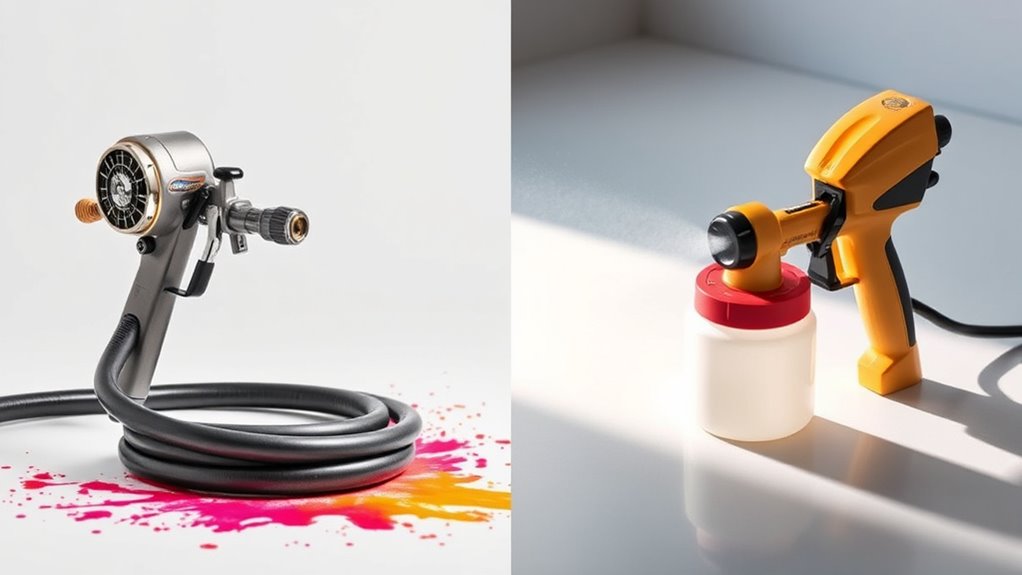
When you’re deciding which paint sprayer to use, consider the size of your project and the surface materials involved.
Airless sprayers are great for large jobs with thick paints, while HVLP sprayers excel in smaller, detailed applications.
Matching the paint thickness to the right sprayer will guarantee you get the best finish possible.
Project Size Considerations
For successful paint projects, it’s essential to match the sprayer type to the project size. Choosing the right sprayer can enhance your efficiency and finish quality.
- Large Projects: Use airless sprayers for quick coverage on exterior house painting or new builds.
- Small Projects: Opt for HVLP sprayers for detailed work and crafts, providing better control and less overspray.
- Medium-Sized Projects: Both airless and HVLP sprayers work here, but airless handles thicker paints more efficiently.
- Ease of Use: If you’re a beginner, stick with HVLP sprayers for their user-friendly operation; airless sprayers may require more experience due to their high pressure and complex spray patterns.
Surface Material Suitability
Surface material suitability plays an essential role in determining which paint sprayer to use for your project.
If you’re tackling exterior surfaces or rough textures, airless sprayers are your best bet. They handle thicker materials like latex paint effectively, making them ideal for large areas.
On the other hand, if your focus is on interior walls or intricate projects, HVLP sprayers shine. They excel on smooth surfaces, providing a high-quality finish with minimal overspray.
For tough surfaces, like concrete or masonry, airless sprayers can apply thick coatings without extensive thinning.
Ultimately, consider the surface materials and the level of detail required to choose the right paint sprayer for your needs.
Paint Thickness Compatibility
Choosing the right paint sprayer depends largely on the thickness of the paint you’re using. Here’s a quick guide to help you decide:
- Airless Paint Sprayers: Best for thicker paints like latex; they handle higher viscosities without thinning.
- HVLP Sprayers: Ideal for thinner materials, such as lacquers and stains; they operate at lower pressure, creating a fine mist.
- Thicker Paints: Use airless sprayers as they can accommodate heavy coatings without clogging.
- Thinner Materials: Go for HVLP sprayers, which may require some paint thinning for best results.
Tips for Choosing the Right Sprayer
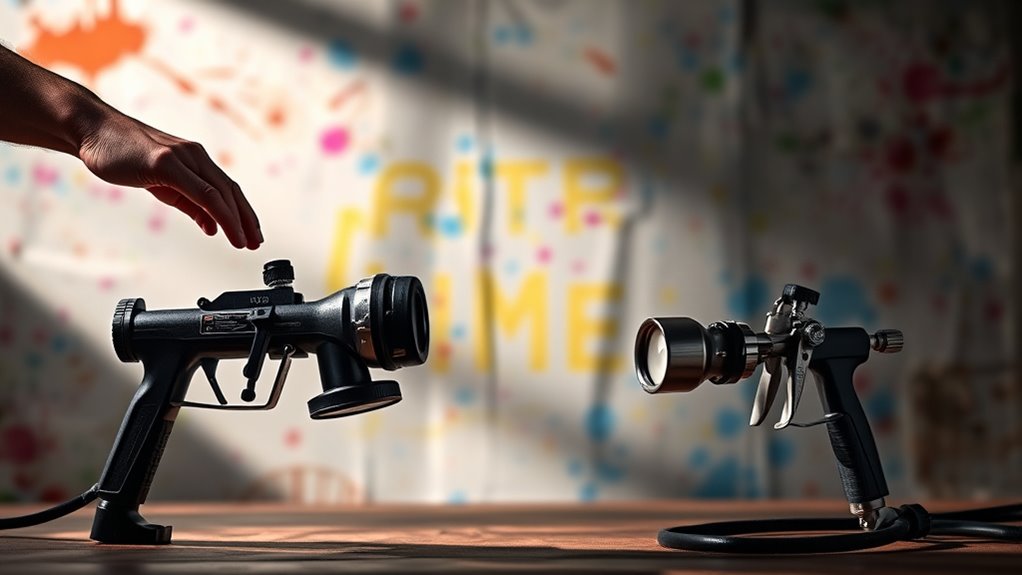
Selecting the right paint sprayer can greatly impact the success of your project. First, consider the size and scope of your task. For larger areas and thicker paints, airless sprayers work best, while HVLP sprayers excel at smaller, detailed jobs like painting furniture.
Next, evaluate the type of surface—airless sprayers handle rough exteriors well, whereas HVLP sprayers shine on smooth, interior surfaces. Think about the type of paint you’ll use; thicker materials suit airless sprayers, and thinner options are best for HVLP.
Finally, assess your skill level. If you’re a beginner, HVLP sprayers offer better control and ease of use. Look for adjustable features for ideal customization to meet your project needs.
Frequently Asked Questions
Which Is Better HVLP or Airless Paint Sprayers?
When deciding whether HVLP or airless paint sprayers are better, think about your specific project needs.
If you’re tackling detailed work or smaller areas, HVLP sprayers might suit you best, offering smooth finishes and less overspray.
However, if you need to cover large surfaces quickly or work with thicker paints, an airless sprayer could be the right choice, despite its potential for overspray and a textured finish.
Your project’s size and type will guide your decision.
What Are the Disadvantages of an HVLP Spray Gun?
Imagine Michelangelo meticulously painting the Sistine Chapel—precision is key.
However, using an HVLP spray gun comes with a few disadvantages. You’ll find it slower for larger projects, requiring thinner paints that may not suit your needs.
Clogging’s a common issue if the paint isn’t thinned properly, and you might end up with longer drying times, needing multiple coats for full coverage.
While overspray is less, it’s still a concern for detailed work.
What Paint Sprayer Do Professional Painters Use?
Professional painters often turn to airless paint sprayers for large projects because they handle thicker paints and cover vast areas quickly.
However, when it comes to detailed work like cabinetry and trim, they prefer HVLP sprayers for their precision and smoother finishes.
Depending on your project, you might find that using a combination of both sprayers can provide the best results, ensuring speed and efficiency where needed, as well as fine detail.
What Are HVLP Paint Sprayers Used For?
HVLP paint sprayers are perfect for small to medium projects where you need a fine finish.
You’ll find them great for furniture refinishing, cabinetry, and detailed crafts, as they provide a smooth, even coat with minimal overspray.
Since they operate at lower pressure, you get better control for intricate work.
They’re also budget-friendly and easy to use, making them an excellent choice for beginners looking to achieve professional-quality results on your projects.
Conclusion
To sum up, choosing between airless and HVLP paint sprayers ultimately depends on your project needs. While some may worry that airless sprayers are too messy, remember that with the right techniques, you can achieve a clean finish quickly. On the other hand, if you prefer precision, HVLP sprayers excel in detail work. Whichever you choose, both options can deliver fantastic results, so don’t hesitate to pick the one that feels right for you and your painting project!

